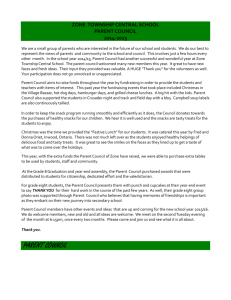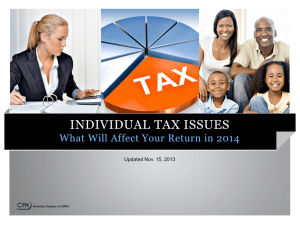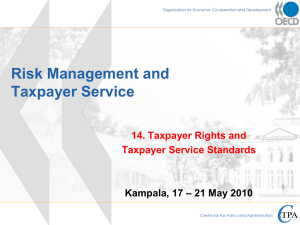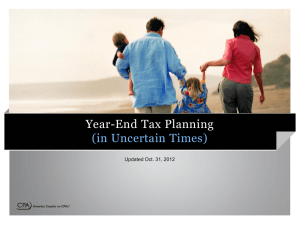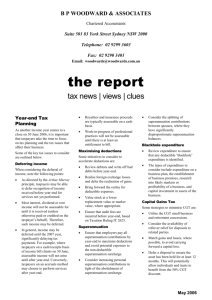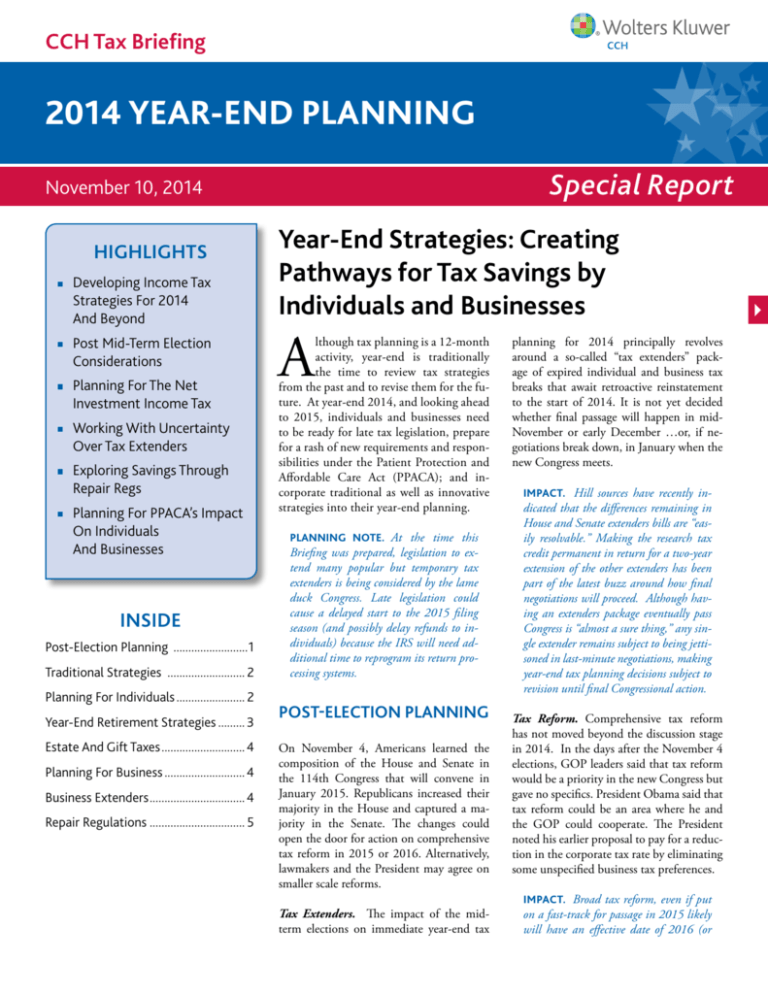
CCH Tax Briefing
2014 YEAR-END PLANNING
Special Report
November 10, 2014
HIGHLIGHTS
Developing Income Tax
Strategies For 2014
And Beyond
Post Mid-Term Election
Considerations
Planning For The Net
Investment Income Tax
Working With Uncertainty
Over Tax Extenders
Exploring Savings Through
Repair Regs
Planning For PPACA’s Impact
On Individuals
And Businesses
INSIDE
Post-Election Planning ..........................1
Traditional Strategies ........................... 2
Planning For Individuals........................ 2
Year-End Retirement Strategies.......... 3
Estate And Gift Taxes............................. 4
Planning For Business............................ 4
Business Extenders................................. 4
Repair Regulations................................. 5
Year-End Strategies: Creating
Pathways for Tax Savings by
Individuals and Businesses
A
lthough tax planning is a 12-month
activity, year-end is traditionally
the time to review tax strategies
from the past and to revise them for the future. At year-end 2014, and looking ahead
to 2015, individuals and businesses need
to be ready for late tax legislation, prepare
for a rash of new requirements and responsibilities under the Patient Protection and
Affordable Care Act (PPACA); and incorporate traditional as well as innovative
strategies into their year-end planning.
PLANNING NOTE. At the time this
Briefing was prepared, legislation to extend many popular but temporary tax
extenders is being considered by the lame
duck Congress. Late legislation could
cause a delayed start to the 2015 filing
season (and possibly delay refunds to individuals) because the IRS will need additional time to reprogram its return processing systems.
POST-ELECTION PLANNING
On November 4, Americans learned the
composition of the House and Senate in
the 114th Congress that will convene in
January 2015. Republicans increased their
majority in the House and captured a majority in the Senate. The changes could
open the door for action on comprehensive
tax reform in 2015 or 2016. Alternatively,
lawmakers and the President may agree on
smaller scale reforms.
Tax Extenders. The impact of the midterm elections on immediate year-end tax
planning for 2014 principally revolves
around a so-called “tax extenders” package of expired individual and business tax
breaks that await retroactive reinstatement
to the start of 2014. It is not yet decided
whether final passage will happen in midNovember or early December …or, if negotiations break down, in January when the
new Congress meets.
IMPACT. Hill sources have recently in-
dicated that the differences remaining in
House and Senate extenders bills are “easily resolvable.” Making the research tax
credit permanent in return for a two-year
extension of the other extenders has been
part of the latest buzz around how final
negotiations will proceed. Although having an extenders package eventually pass
Congress is “almost a sure thing,” any single extender remains subject to being jettisoned in last-minute negotiations, making
year-end tax planning decisions subject to
revision until final Congressional action.
Tax Reform. Comprehensive tax reform
has not moved beyond the discussion stage
in 2014. In the days after the November 4
elections, GOP leaders said that tax reform
would be a priority in the new Congress but
gave no specifics. President Obama said that
tax reform could be an area where he and
the GOP could cooperate. The President
noted his earlier proposal to pay for a reduction in the corporate tax rate by eliminating
some unspecified business tax preferences.
IMPACT. Broad tax reform, even if put
on a fast-track for passage in 2015 likely
will have an effective date of 2016 (or
2014 Year-End Planning
2
even later with phased-in provisions). An
exception, however, may be carved out for
sooner action on corporate inversions.
Health Care. Several provisions of the PPACA could be modified or repealed in the
114th Congress. Those being considered
for action in the near future include rolling
back the 2.3 percent medical device excise
tax and the 30-hour rule for treatment as
a full-time employee for purposes of the
employer shared responsibility requirement.
The latter change would especially impact
current planning by employers on avoiding
liability under the employer mandate.
IRS. The IRS operated in FY 2014 at the
same rate of funding as FY 2013 and at
roughly $850 million below FY 2010 levels. The lame-duck Congress is expected to
approve an omnibus spending bill to fund
the IRS through the end of FY 2015. The
GOP-controlled 114th Congress will prepare the IRS budget for FY 2016.
TRADITIONAL
YEAR-END STRATEGIES
Year-end 2014 presents unique challenges. At the same time, traditional year-end
planning techniques nevertheless remain
important both to maximize benefits in
connection with what’s new and to do so
within the usual ebb and flow of the taxpayer’s personal economy. The following
traditional income and deduction acceleration techniques and their reciprocal deferral strategies should be considered:
Income Deferral/Acceleration:
Enter into/ Sell installment contracts
Defer/ Receive bonuses before January
Hold/ Sell appreciated assets
Accelerate income to use available carryforward losses
Hold/ Redeem U.S. Savings Bonds
Accumulate/ Declare special dividend
Postpone/ Complete Roth conversions
Delay/ Accelerate debt forgiveness income
Minimize/ Maximize retirement distributions
CCH Tax Briefing
Delay/ Accelerate billable services
Structure/ Avoid mandatory like-kind
exchange treatment
Deductions and Credits
Acceleration/Deferral
Bunch itemized deductions into 2014
and take standard deduction in 2015/
reverse steps
Pay bills in 2014/ postpone payments
until 2015
Pay last state estimated tax installment
in 2014/ delay payment until 2015
Accelerate economic performance/ postpone performance
Watch AGI limitations on deductions/
credits
Watch net investment interest restrictions
Match passive activity income and losses
“Year-end 2014 presents
unique challenges.”
YEAR-END
INDIVIDUAL PLANNING
For individuals, the income tax rates for
2014 are unchanged from 2013: 10, 15,
25, 28, 33, 35 and 39.6 percent. The top
tax rate for qualified capital gains and
dividends is also unchanged from 2013:
20 percent.
STRATEGY. Year-end planning should
look to avoiding spikes in income, whether capital gains or other income, which
for higher-income taxpayers may push
capital gains into either the 39.6 percent bracket for short-term gains or the
20 percent capital gains bracket for longterm gains. Spreading the recognition of
certain income between 2014 and 2015
may accomplish this goal.
Net Investment Income (NII) Tax
Since 2013, taxpayers with qualifying income are liable for the 3.8 percent net
investment income (NII) tax. The threshold
amounts for the NII tax are:
$250,000 in the case of joint returns or
a surviving spouse,
$125,000 in the case of a married taxpayer filing a separate return, and
$200,000 in any other case.
STRATEGY. All net investment income should be monitored for exposure
to the NII tax. Net investment income
is more than simply capital gains and
dividends. It also includes income from
a business in which the taxpayer is a
passive participant. Rental income may
also be considered NII unless earned by
a real estate professional.
STRATEGY. Taxpayers with potential NII
liability should consider keeping income
below the $250,000/$125,000/$200,000
thresholds if possible by spreading income
out over a number of years or offsetting
the income with both above-the-line and
itemized deductions.
Additional Medicare Tax
The Additional Medicare Tax increases the
employee share of Medicare tax by an additional 0.9 percent of covered wages in excess
of certain threshold amounts. The tax also
increases Medicare tax on self-employment
income by an additional 0.9 percent of selfemployment income in excess of the threshold amounts. The threshold amounts are:
$200,000 for single individuals (and heads
of household); $250,000 for married couples filing a joint return; and $125,000 for
married individuals filing separate returns.
STRATEGY. This is now the second year
in which affected taxpayers will file returns reflecting Additional Medicare
Tax. Taxpayers who only now realize
that they have had insufficient income
tax withholding may request that their
employer(s) take out an additional
amount of income tax withholding,
which would be applied against taxes
shown on the taxpayer’s individual
income tax return, including any
©2014 CCH Incorporated. All Rights Reserved.
November 10, 2014
3
Additional Medicare Tax liability.
Taxpayers may also consider making
estimated tax payments.
Alternative Minimum Tax
The alternative minimum tax (AMT) is
now permanently “patched.” The patch
provides for increased exemption amounts
and allows taxpayers to take all of the nonrefundable personal credits against regular
and AMT liability.
STRATEGY. Even with the permanent
patch, taxpayers should continue to review
their AMT liability versus regular tax liability. For some taxpayers, AMT liability
and regular tax liability may be roughly
equal from year to year. Other taxpayers
may find that they have had significant
fluctuations in income or AMT-targeted
tax benefits from year to year and could
explore the benefit from being able to
shift some AMT-triggering items from an
AMT year to a non-AMT year.
Pease Limitation/PEP
The Pease limitation reduces the total amount
of a higher-income taxpayer’s otherwise allowable itemized deductions by three percent of
the amount by which the taxpayer’s adjusted
gross income exceeds an applicable threshold.
However, the amount of itemized deductions
is not reduced by more than 80 percent. Taxpayers who find themselves within thresholdadjusted gross income amounts that make
them subject to the Pease Limitation will also
need to plan for the revived personal exemption phaseout (PEP).
Individual Tax Extenders
Under current law – the individual extenders (as well as the business extenders discussed below) – are unavailable for 2014
and subsequent years, unless extended by
Congress. For individuals, they include the
state and local sales tax deduction, special
mortgage debt forgiveness provisions, transit benefits parity, higher education tuition
deduction, IRA distributions to charities,
and teachers’ classroom expense deduction.
PLANNING NOTE. While some “extend-
ers” legislation is eventually expected, the
extent of what will be covered remains
uncertain at press time. Some temporary individual incentives are available
for 2014 and 2015 because they carry
different expiration dates. They include
the American Opportunity Tax Credit
(AOTC) and the Code Sec. 25D residential energy efficient credit.
Affordable Care Act
Effective January 1, 2014, the PPACA
requires individuals, unless exempt, to
carry minimum essential health insurance coverage for each month or make an
individual shared responsibility payment.
Individuals liable for a shared responsibility payment during 2014 will make
their payment when they file their 2014
returns. Individuals who obtain health
insurance coverage through the PPACA
Marketplace may be eligible for the Code
Sec. 36B premium assistance tax credit
to help offset the cost of coverage. 2014
was the first year that the Code Sec. 36B
credit was available.
PLANNING NOTE. Taxpayers who elect
to receive advance payments of the Code
Sec. 36B credit must reconcile on their
returns the amount forwarded to insurers
with the credit they may claim.
Year-End Retirement Strategies
Generally, all types of qualified plans (as
well as traditional individual retirement accounts) must satisfy a required minimum
distribution (RMD) in which distribution
of an employee’s or IRA owner’s interest in
the plan or IRA must begin by the “required
beginning date.”
PLANNING NOTE. Two year-end deadlines should be kept in mind: (1) The
RMD for any given year is based on the
retirement account balance on December 31 of the calendar year immediately
before the year of distribution; and (2)
The RMD for any year generally must
take place by December 31 of that year.
The interplay of these two deadlines will
reach increasing importance as baby
boomers begin to retire, and to do so with
fewer pensions and a greater number of
retirement account balances to manage.
In Bobrow, TC Memo. 2014-21, the Tax
Court held that a taxpayer could make
only one nontaxable rollover contribution
within each one-year period regardless of
how many IRAs the taxpayer maintained.
The one-year limitation under Code Sec.
408(d)(3)(B) is not specific to any single
IRA maintained by an individual but instead applies to all IRAs maintained by a
taxpayer, the court found.
LIFE CYCLE CHANGES IMPORTANT TO
YEAR-END STRATEGIES
In addition to changes in the tax law, year-end tax strategies should also consider personal circumstances that changed during 2014 as well as what may change in 2015.
These “life cycle” events include:
Change in filing status: marriage, divorce,
death or head of household changes
Birth of a child
Child no longer young enough for
child credit
Child who has outgrown the “kiddie” tax
Casualty losses
Changes in medical expenses
Moving/relocation
College and other tuition expenses
Employment changes
Retirement
Personal bankruptcy
Large inheritance
Business successes or failures
CCH Tax Briefing
2014 Year-End Planning
4
PLANNING NOTE. The Bobrow decision
affects only IRA to IRA rollovers managed
by the account holders, and does not limit
trustee-to-trustee transfers. For planning
purposes, the pre-Bobrow rule will continue to apply to IRA distributions occurring
before January 1, 2015.
Estate and Gift Taxes
The maximum federal unified estate and gift
tax rate is 40 percent with an inflation-adjusted $5 million exclusion for gifts made and
estates of decedents dying after December
31, 2012. The gift tax exclusion allows taxpayers to give up to an inflation-adjusted
$14,000 to any individual, gift-tax free and
without counting the amount of the gift
toward the lifetime $5 million exclusion,
adjusted for inflation.
PLANNING NOTE. The applicable ex-
clusion amount, as adjusted for inflation, is $5,340,000 for gifts made and
estates of decedents dying in 2014 and
rises to $5,430,000 in 2015.
PLANNING NOTE. There is no limit on
the number of individual donees to whom
gifts may be made under the $14,000
exclusion. Spouses may “split” their gifts
to each donee, effectively raising the per
donee annual maximum exclusion to
$28,000. Spouses may give an unlimited
amount of gifts to one another without
any gift tax imposed.
YEAR-END
BUSINESS PLANNING
Businesses seeking to maximize tax benefits
through 2014 year-end tax planning may
want to consider three general strategies:
(1) Use of traditional timing techniques for
income and deductions; (2) Special consideration of significant tax incentives that
expired at the end of 2013 but may be extended through 2014; and (3) Reaction to
certain recent tax developments from IRS
and the courts that may present either new
opportunities or pitfalls.
CCH Tax Briefing
Bonus Depreciation
For tax years after 2013, bonus depreciation
has officially expired (except for certain noncommercial aircraft and longer production
period property which may be eligible for 50
percent bonus depreciation through 2014).
STRATEGY. Although the possibility of
retroactive reinstatement of the bonus-depreciation election should be factored into
a year-end strategy, a final decision on
making it is not required until a return
is filed. Further, bonus depreciation is
not mandatory. Certain taxpayers should
consider electing out of bonus depreciation to spread depreciation deductions
more evenly over future years.
“Business incentives that
officially expired after
2013 include enhanced
Code Sec. 179 expensing,
the Work Opportunity
Tax Credit (WOTC)…and
many more.”
Research Tax Credit
The research tax credit also officially expired
after 2013, but it may be retroactively revived by Congress. The research credit may
be claimed for increases in business-related
qualified research expenditures and for increases in payments to universities and other
qualified organizations for basic research.
The credit applies to the excess of qualified
research expenditures for the tax year over the
average annual qualified research expenditures measured over the four preceding years.
Small Business Stock
A full 100-percent gain exclusion applies
to qualified small business stock that is
acquired after September 27, 2010, and
before January 1, 2014, and held for more
than five years. Under current law, the
percentage that is excluded is 50-percent
(60-percent for empowerment zone stock)
for qualifying stock acquired after December 31, 2013.
STRATEGY. Even with the reduced ex-
clusion, the provision is a worthwhile
strategy. Taxpayers should consider
making investments before year-end
2014 so that the required five-year
holding period begins to run. Also to
keep in mind is that being even a single
day short of the five-year period - measured from the acquisition date - eliminates any benefit, with no proration
allowed. Certain exchanges of similar
stock before the five year period, however, are permitted.
Code Sec. 199 Deduction
The Code Sec. 199 deduction allows taxpayers to deduct an amount equal to the lesser
of a phased-in percentage of taxable income
(adjusted gross income for individuals)
or qualified production activities income.
The deduction is calculated as a percentage
(generally nine percent under current law,
subject to some exceptions) of qualified production activities income.
PLANNING NOTE. The Code Sec. 199
deduction is often viewed as being underutilized. Taxpayers should not let the
complexity of the calculations deter potential savings under the deduction.
Business Extenders
Business incentives that have officially expired after 2013, unless revived by Congress, include, in addition to bonus depreciation and the enhanced Code Sec.
179 expensing, the Work Opportunity
Tax Credit (WOTC), Indian employment
credit, special expensing rules for film and
television productions, and many other
temporary provisions.
©2014 CCH Incorporated. All Rights Reserved.
November 10, 2014
5
Affordable Care Act
Effective January 1, 2015, the PPACA’s employer shared responsibility requirements
(“employer mandate”) take effect for applicable large employers. However, there is a
carve-out for mid-size employers for 2015.
Some relaxed standards for larger employers
also are available in 2015.
PLANNING NOTE. Employers with
fewer than 50 full-time employees (including full-time equivalent employees)
are completely exempt from the employer mandate for any year. Employers with at least 50 but fewer than 100
full-time employees (including full-time
equivalent employees) are exempt from
the employer mandate until 2016; and
employers with 100 or more full-time
employees (including full-time equivalent employees) are subject to the employer mandate starting in 2015, with
certain relaxed standards.
Repair Regulations
Final regulations for treating costs related
to tangible property (the so-called “repair
regulations”) may open significant tax planning opportunities. For acquisitions of tangible property, a de minimis safe harbor allows taxpayers to deduct certain items. The
safe harbor applies to items that cost $5,000
or less (per item or invoice) and that are deducted on the company’s applicable financial statement (AFS) in accordance with a
written accounting procedure.
STRATEGY. Under the $5,000 de mini-
mis safe harbor in the final regulations,
taxpayers must have a written policy in
place at the beginning of the year that specifies a dollar amount for following book
treatment. The de minimis safe harbor is
an annual election and not an accounting
method, so it can be made and changed
every year. Calendar-year taxpayers need
to have a written policy in place by yearend 2014 to qualify for 2015. The annual
election is made by filing a statement with
the taxpayer’s income tax return.
PLANNING NOTE. The de minimis
limit is $500 per item or invoice for companies without an AFS. A written policy,
while not required here, is nevertheless
recommended.
Introducing CCH ® Tax Perspectives
CCH® Federal Tax Perspectives: 2014 Year-End Planning eBook
Receive an overview of the latest developments as well as authoritative comments
and planning notes from Wolters Kluwer’s industry-leading editorial experts.
●
●
●
Plan and recognize many of the Patient Protection and Affordable Care Act provisions, including
the far-reaching net investment income tax
Guidance on business incentives that have expired and availability to taxpayers on their 2014 returns
Key new developments, including compliance with the sweeping repair regulations, evolving rules
and regulations in areas such as retirement planning
Just $19.95
BUY NOW
Also Available:
CCH® State Tax Perspectives: 2014
California Tax Updates and Insights
eBook .............................................. $19.95
U.S. Master Tax Guide®, 2015
............................................................$97.25
Attend CCH Seminars
and Earn CPE!
BUY NOW
Authoritative seminars in the convenience of your office
on a variety of tax and accounting topics, including the
latest developments and tax legislation changes.
BUY NOW
Visit CCHGroup.com/Seminars for a calendar
of upcoming CCH Seminars.
eBooks and eBook combinations can only be purchased online. eBooks cannot be returned for credit or put on standing order.
Visit CCHGroup.com/eBooks to learn more about ordering eBooks online and to review our end-user agreement.
Visit CCHGroup.com/Legislation for the latest updates as they happen.
CCH Tax Briefing

